General Advice for Insight¶
README file must be impeccable.
Practice +++ coding / interviewing with your fellows.
Mock interviews, check-ins: it's ok to cry.
It's all going to be OK.
Overview¶
- Version Control
- Brief Terminology
- Contributing to Personal Repos
- Contributing to Repos in Teams
Version Control: Why?¶
- Keep track of code, its changes, all in one place.
- Multiple versions of code
- Doc changes from you (troubleshooting) or others (PyTorch, e.g.)

- Ability to collaborate
- Experiment without interferring others' work
- Tracks who-done-it and when
- Industry Standard: Insight (practice, demo) -> Future Positions

- Risky not to use, plus it's FREE!
Slides provide guidelines¶
- Outlines majority of expected usage/reqs
- Provides a streamlined workflow for collaborative teams
Main goal: understand & encourage following these guidelines¶
Terminology Overview¶
| Places | Actions | Communications |
|---|---|---|
| repositories | fork | remote |
| fork | push | issues |
| upstream | pull | pull request |
| local | merge | . |
| . | commit | . |
| . | fetch | . |
Sort of loose, conceptual categories for these slides...
Repositories¶
- Magical place (GitHub server) where your project lives, repo officially ends in .git
- Well organized, documented (README, checklist)
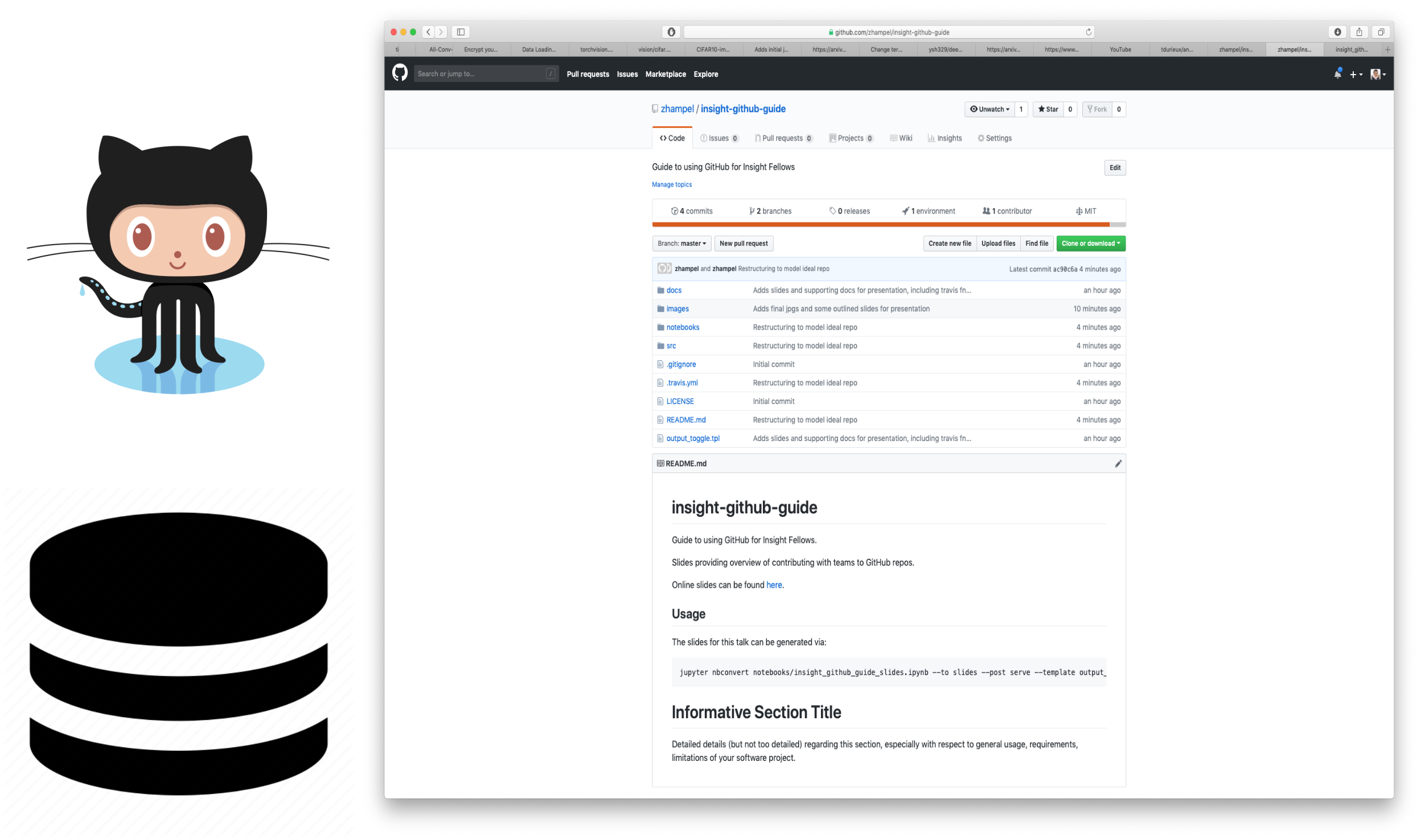
Repo in terms of version control¶
Origin repo has sequentially tracked versions
- One master, may have many branches
- Dots represent changes to project along specified branch

But how to make these changes?¶
Local Working Copy¶
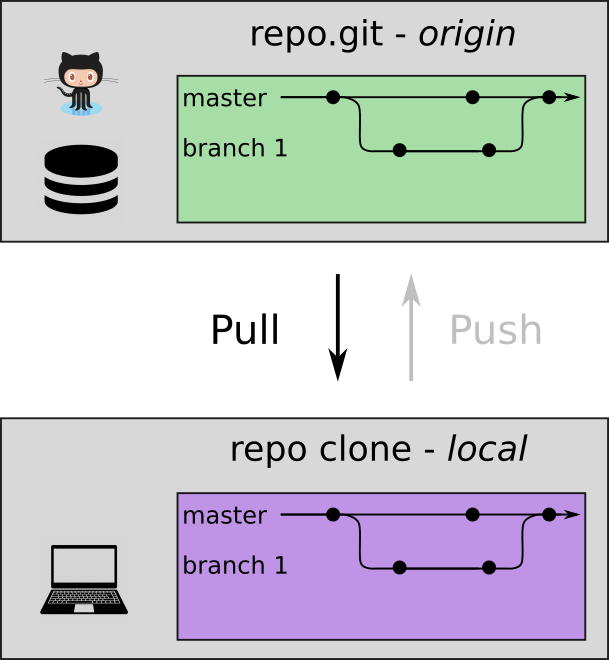
One must pull the origin to workstation for local repo clone/copy.
git clone https://github.com/<username>/<repo>.git
Local Work¶
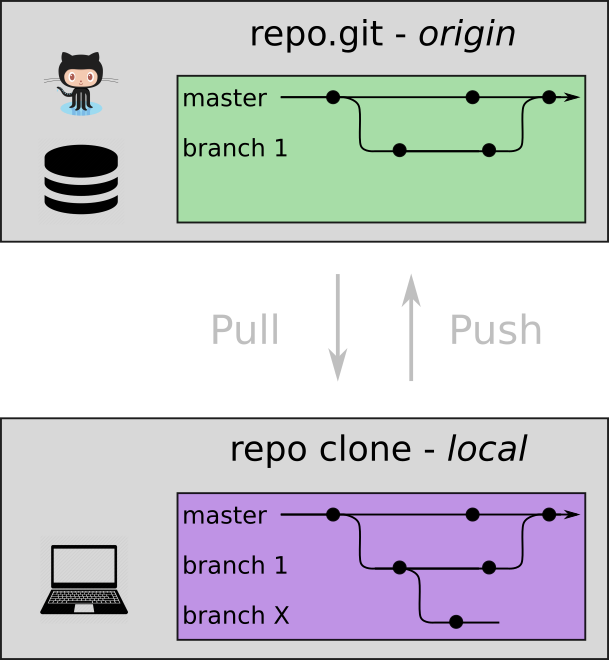
Can make changes locally on master branch or topically named branch:
git checkout -b leafy_branch
Local Work¶

As a quick aside, always good to run frequently
git statusto get more info
Can also check what available branches are present via
git branch
Local Commits¶

When work is done, prep via add and commit!
git add <modified_file_list_here>git commit -m '<meaningful short message of changes>'
This preps changes in a buffer ready for the main repo
Update the Origin¶
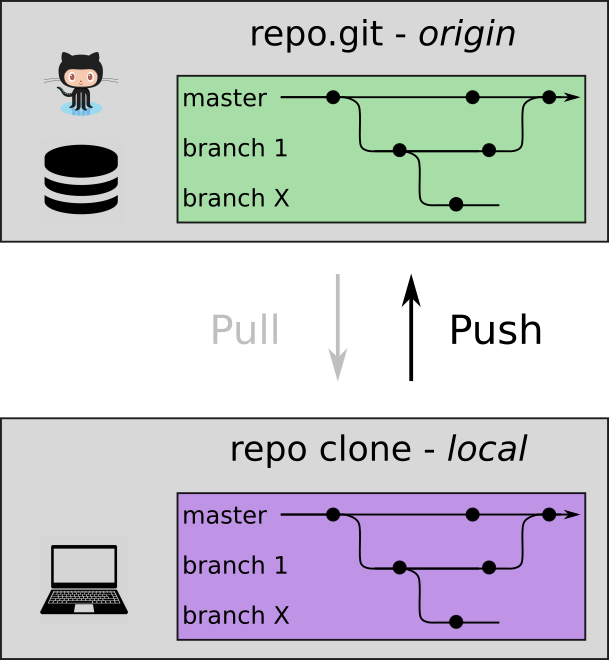
Push local work to origin
git pushgit push origin X
depending if changes to master or X
Personal Repos Wrap-Up¶
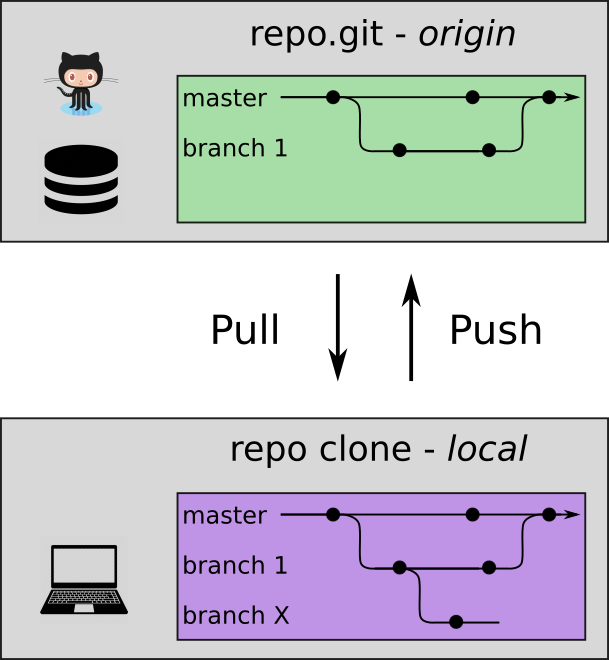
These commands are used more for personal repos, for which you are the creator.
So what if you have friends?
Repo is Somewhere Else on GitHub¶

You must fork the repo! Done directly on GitHub
Makes a copy of the repo at its current state in your account
Roles Change Once Forked¶

Now treat forked repo as origin, as before
Won't be working on upstream till later.
Local Work Again¶
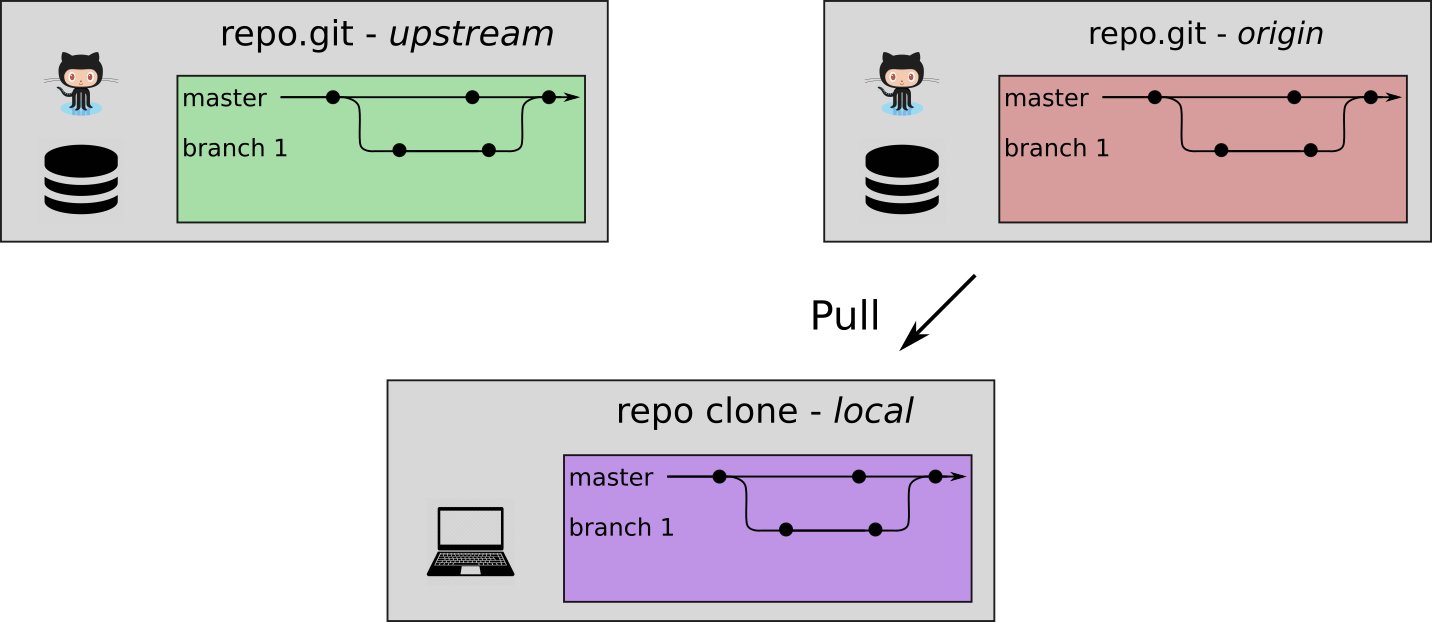
After the fork, origin is repo in your account
Repo you forked from becomes upstream, pull/push from origin as usual
What about if changes are made since to the upstream you forked from???!!!
You sync them up!¶
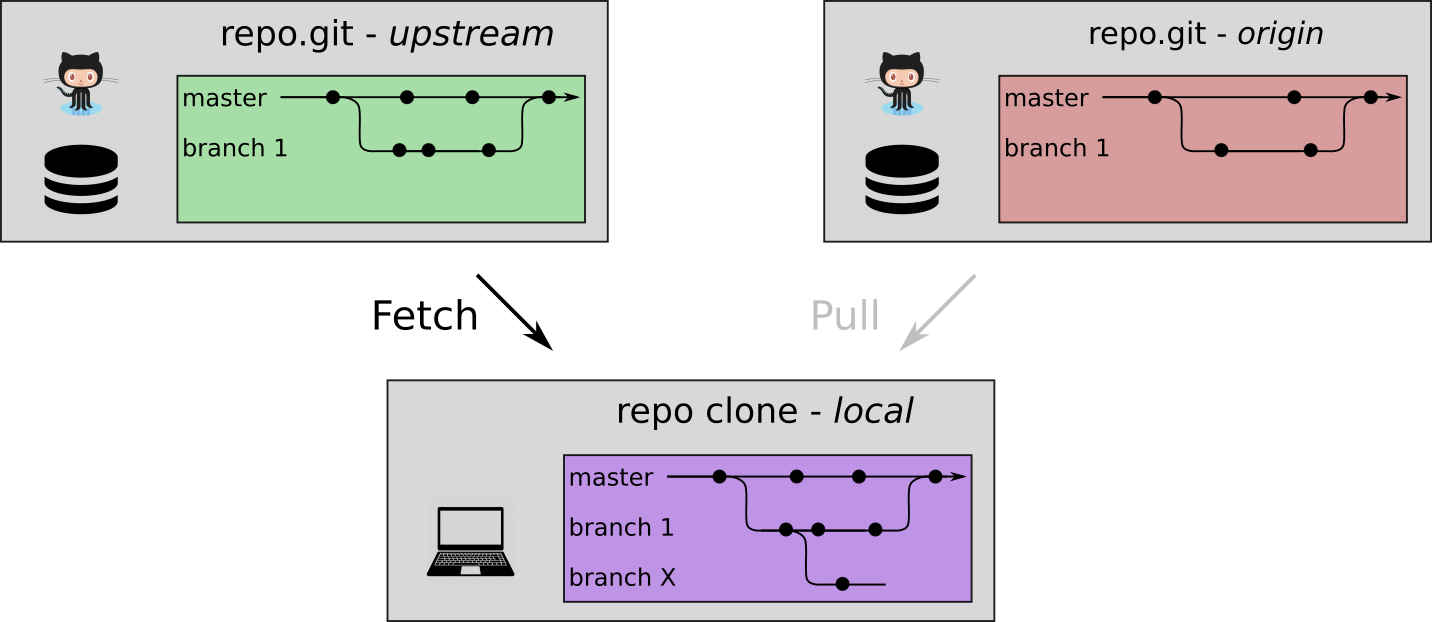
Create a remote to the upstream repo
git remote add upstream https://github.com/<someones_username>/<repo>.git
You sync them up!¶

Then sync the local one by fetching the upstream, then merging it and the local master
git fetch upstreamgit checkout mastergit merge upstream/master
Now get to work as usual...¶
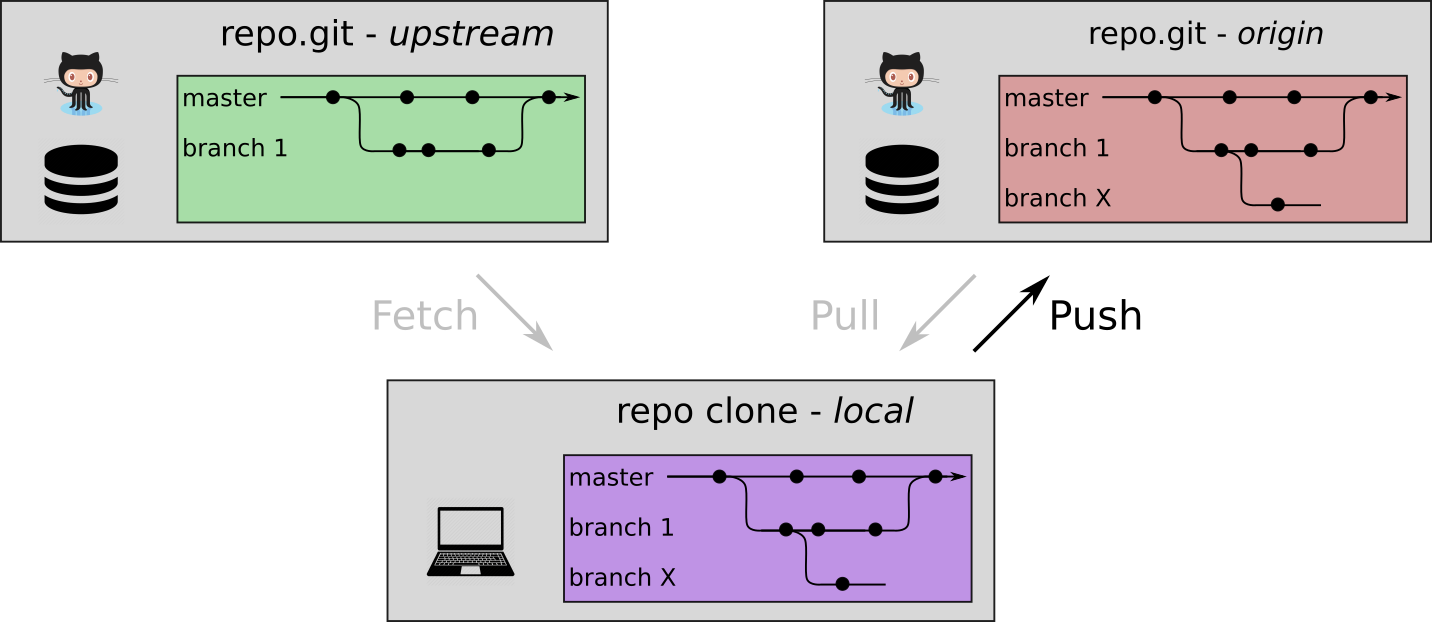
- Make new branches and write new code
- Add changed files, commit and push to origin
After pushing...¶
So far, push only changed your forked repo, the origin.
Ask changes to be reflected in upstream via Pull Request

Alerts maintainer to review requested changes. One should:
- Check if changes solve an open issue, otherwise open a new issue.

- Statement in PR box detailing changes.
- Assign yourself
- Request review to look for errors, conflicts, etc
- Do Not merge, only done by the reviewer!
Collaborative Effort¶
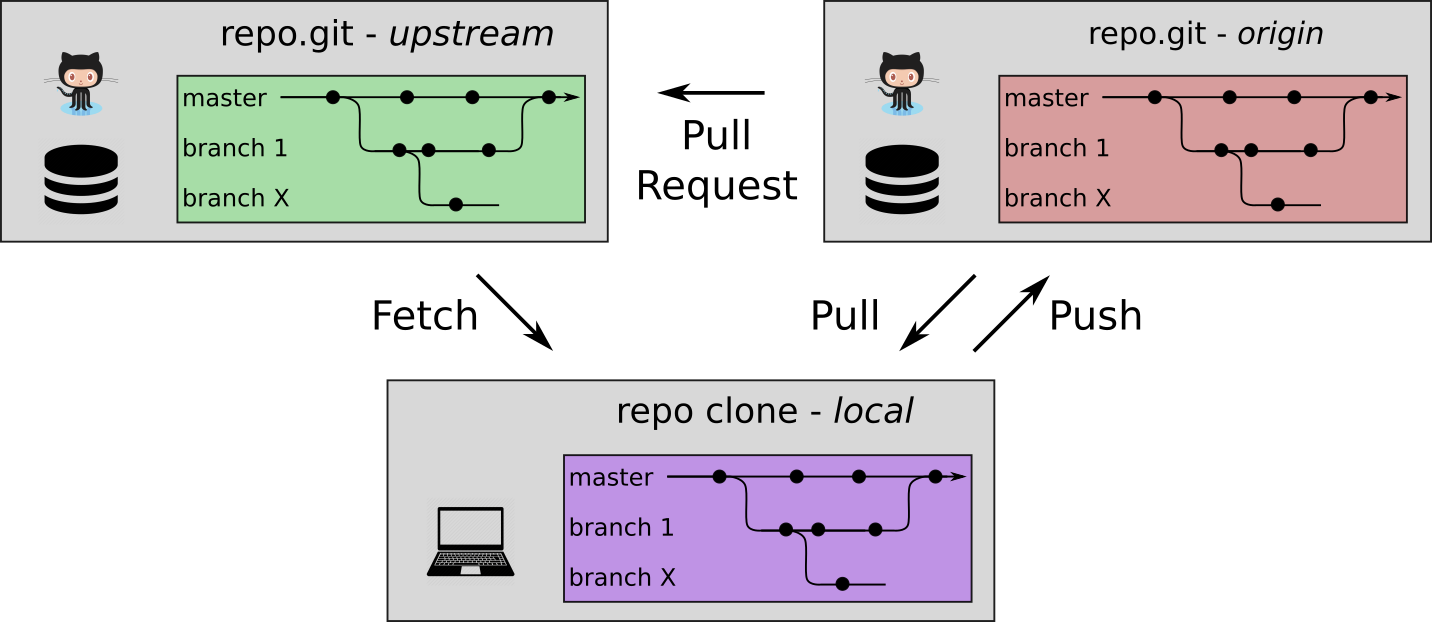
Comparison¶
| Collaborative Work | . | Personal Repo Work |
|---|---|---|
 |
. |  |
Some Best Practices & Comments¶
General
- Use
git statusoften - Commits short:
git commit -m "Adds input feature x to script y" - Add tech advisor as collaborator
Personal Repos
- Can work on master, branches show mastery...
Collaborative Work
- Extension: contribute safely to codebase, avoid conflicts
- Addition of fork, remote/fetch prior to work
- PR after normal steps when code is deliverable (code review...)
- Never merge a PR to a codebase unless you are the reviewer.
Summary¶
- Hopefully, the functionality of GitHub is clearer
- Set of commands for 90% work
- Potentially improve performance of team
- Provide systematic review in main codebase
- Is safest, most efficient manner to streamline contributions to repos in teams
- Finally, example checklist you can test commands on in this very repo!
Final Comments¶
- Talk to your mentors / tech-advisors
- Check-ins, mock interviews
- Issues, problems, doubts?
- Ask questions
- Real interviews
- Be reserved, but honest
- Sleep well the two nights before
- Ask questions (talking time, get to know potential colleagues)
- Make sure your README file is impeccable.
- Make sure your README file is impeccable.
Command Line Sequences¶
Personal Repos¶
- Create a new repo named repo_name on your GitHub :)
- On your work station, clone the repo
git clone https://github.com/<your_username>/<repo_name>.gitcd repo_name
- You are now in a local copy of the origin-al repo
- You are on the master branch until you decide to make a new branch
git checkout -b <new_branch>git branchorgit statusto get more info
- Can checkout other existing branches easily
git checkout <other_branch_name>git checkout masterof course
- For more info
git branchorgit status
Personal Repo - Command Line Sequence¶
git clone https://github.com/<your_username>/<repo_name>.gitcd repo_namegit checkout -b <new_feature_branch_name>git add <modified_file_list_here>git commit -m '<meaningful short message about the changes made>'git push origin <new_feature_branch_name>- If pushed to master branch, no worries. Otherwise, can go to your repo on GitHub and submit a Pull Request.
Contributing to Repo - Command Line Sequence¶
- Fork the Repo

git clone https://github.com/<your_username>/<repo_name>.gitcd repo_namegit remote add upstream https://github.com/<upstream_username>/<repo_name>.gitgit remote -vgit fetch upstreamgit checkout mastergit merge upstream/master- If fixing/adding, good idea to submit a ticket. Assign yourself, add labels, etc.

Contributing to Repo - Continued¶
git checkout -b <new_feature_branch_name>- Do what you do best
git add <modified_file_list_here>git commit -m '<meaningful short message about the changes made>'git push origin <new_feature_branch_name>- Go to your repo on GitHub and submit a pull request! Can request reviewer, assign yourself, add labels, etc.

- After PR accepted go back to
git fetch upstreamstep and keep contributing!

